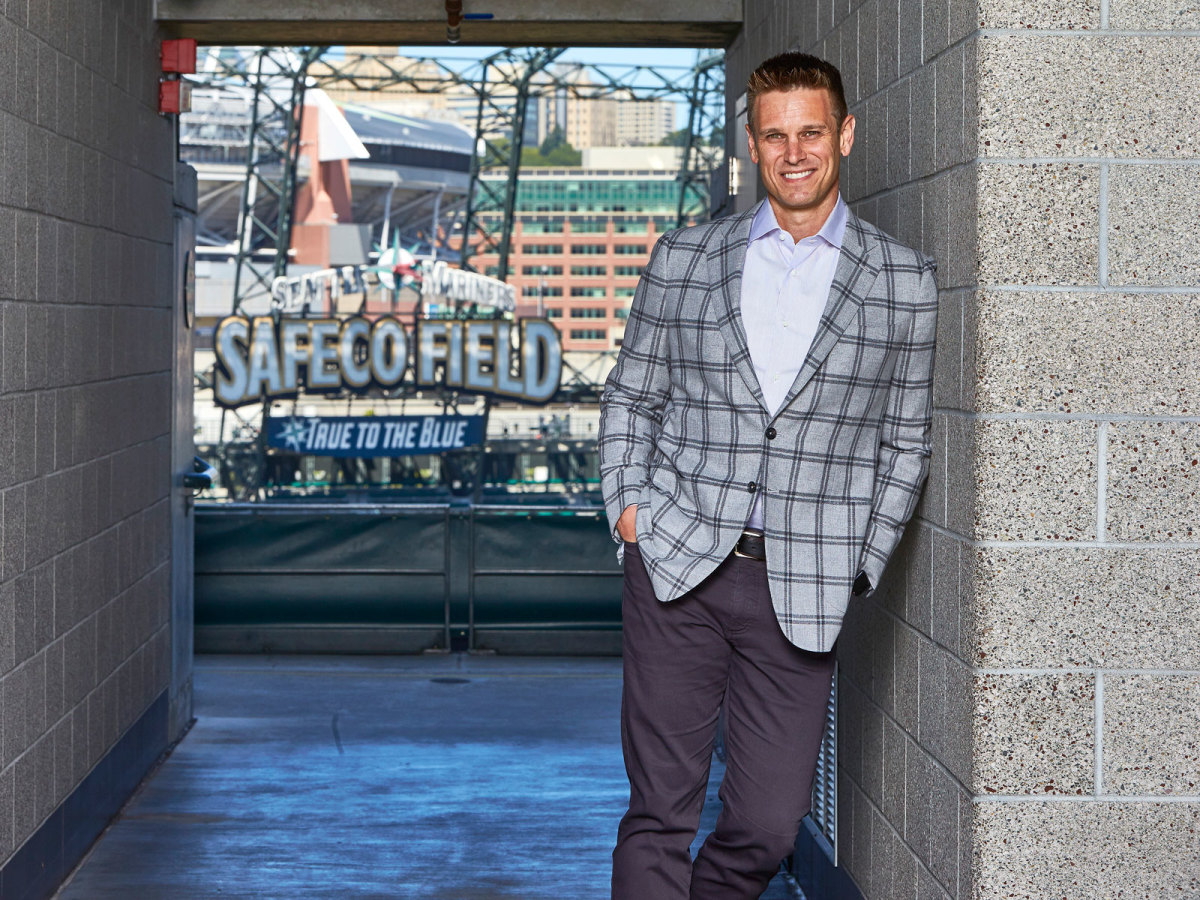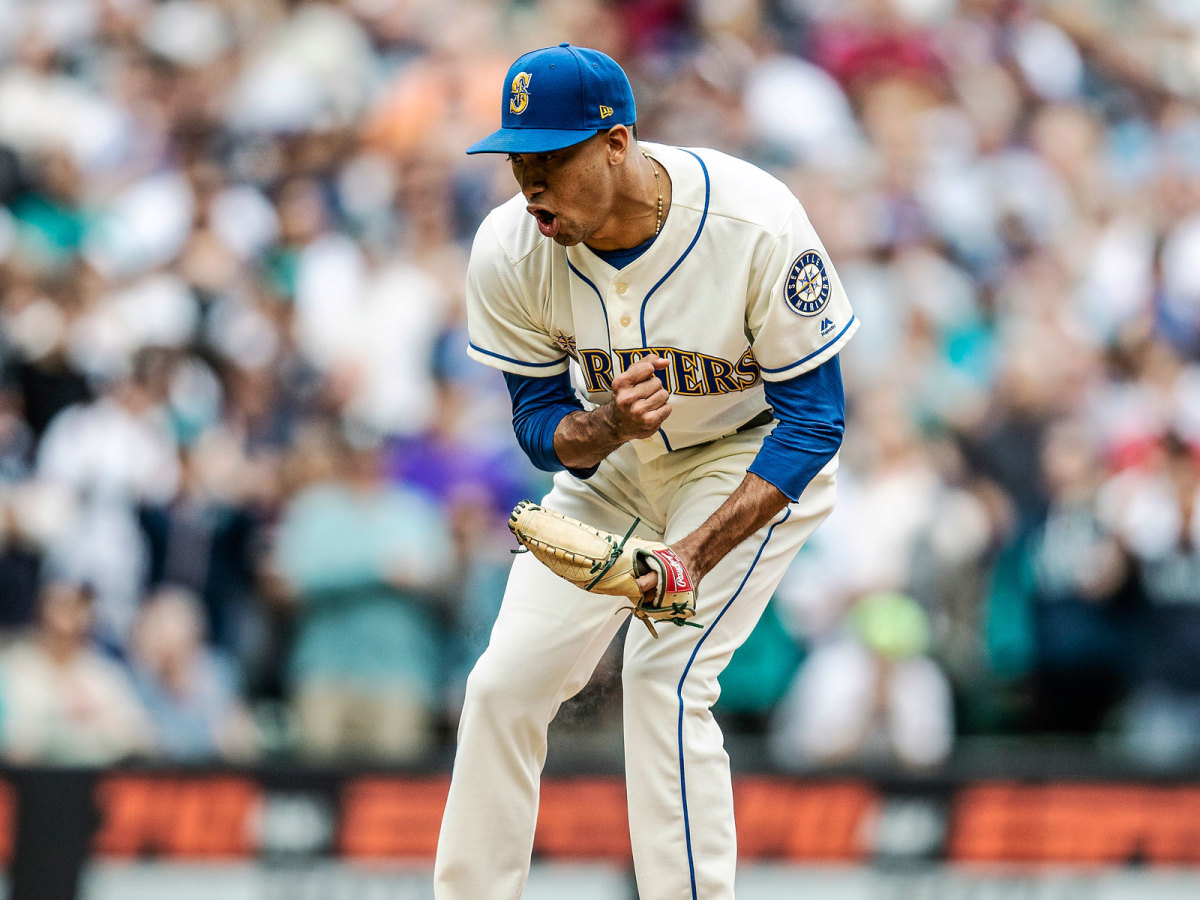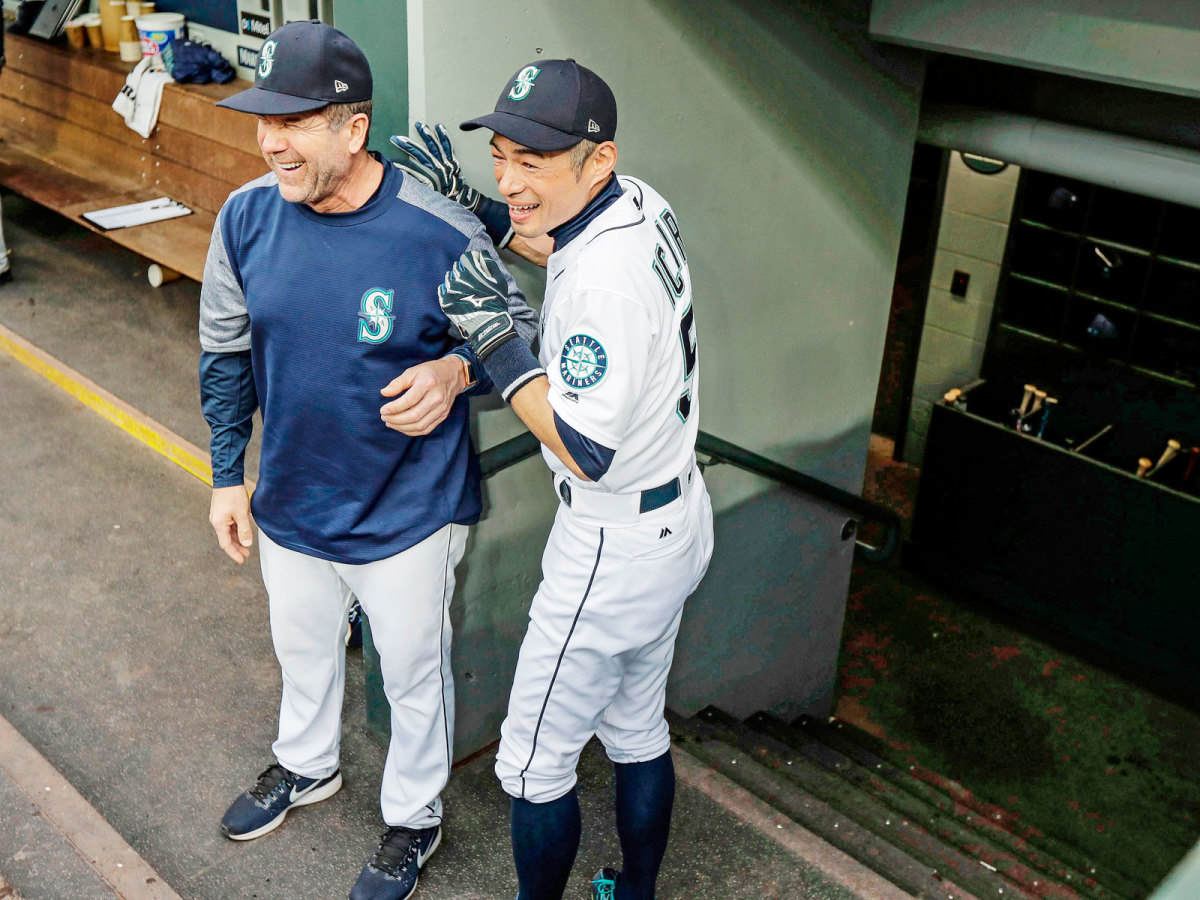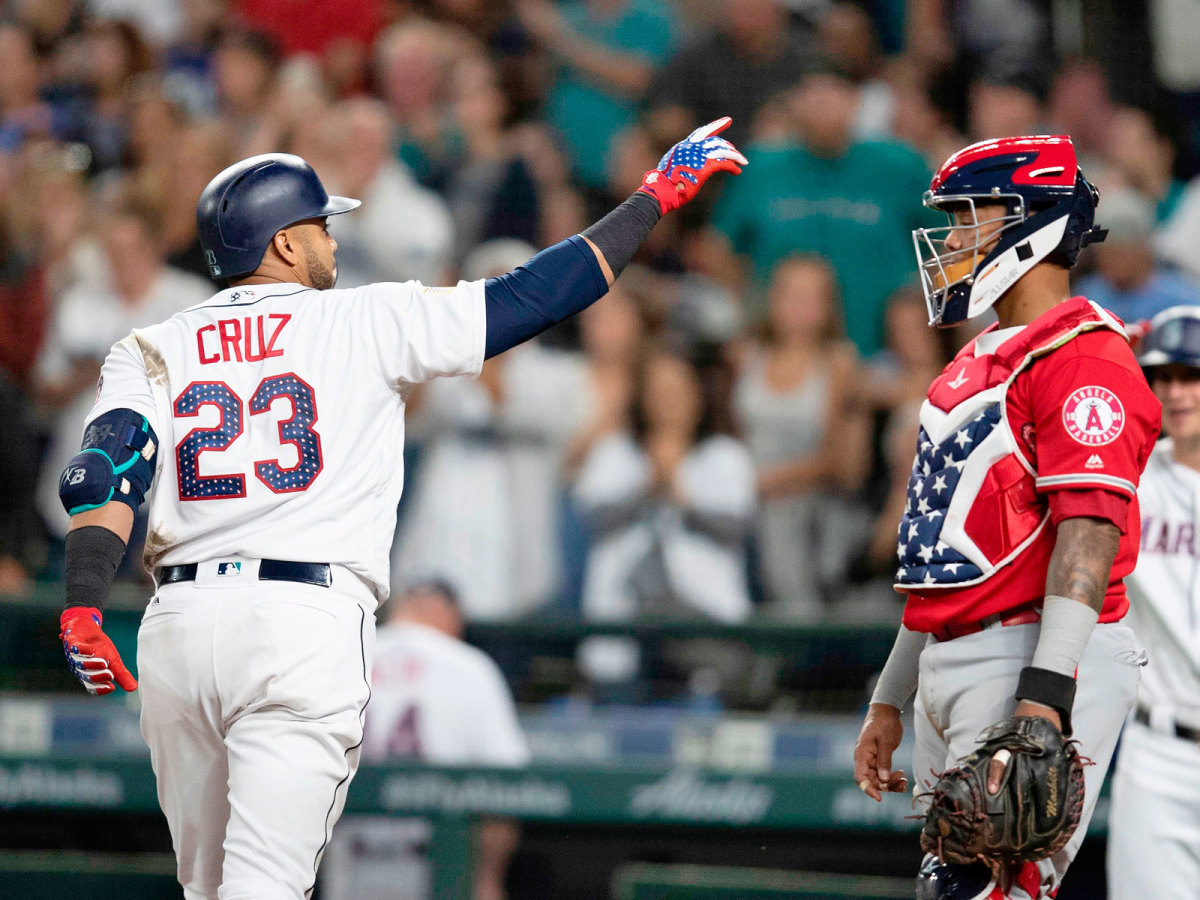Will It Work? A Week With the Mariners as They Try to End the Longest Playoff Drought in Pro Sports

This story appears in the July 30, 2018, issue of Sports Illustrated. For more great storytelling and in-depth analysis, subscribe to the magazine—and get up to 94% off the cover price. Click here for more.
Saturday, June 30
Jerry Dipoto sits behind his desk in an office high above Safeco Field. Behind him are shelves lined with books on human behavior like The Subtle Art of Not Giving a F--- and The Undoing Project, Michael Lewis’s tome on behavioral economics. A few hundred feet below, a vivid example of human behavior: a large, bearded man is standing on a street corner screaming into a bullhorn about the apocalypse. “The End is near!” the man shouts, while Dipoto’s phone buzzes, traffic creeps along outside his window and his team marches into long-forgotten territory known as a pennant race.
In the Moneyball era, the caricature of the baseball general manager has been the awkward, aloof Ivy Leaguer who treated numbers like secrets to the universe. That’s not Dipoto, the Mariners GM who’s more like an entrepreneur who happens to run a baseball team. He not only favors the look of a tech executive—stylish, trim, dress shirt, no tie—but he also refers to his methods with such phrases as new paradigm and high-performance model as he cuts the figure of a CEO who embraces both the numbers and the human element. If you couldn’t see the baseball mitt that holds his business cards, you might think you’d wandered into Amazon corporate headquarters down the road.
Dipoto is, in fact, a former player who has spent his entire career inside the game. He says his thinking was shaped more than a decade ago, inside a two-bedroom apartment he shared in Tucson during spring training, with another like-minded former major leaguer named Scott Servais. It was the mid 2000s, and Dipoto was an assistant to Colorado’s general manager; Servais was a Rockies scout. Each night they’d retire to the kitchen table, crack open a bottle of red and argue about baseball until someone went to bed in a huff. Their player-evaluation system was born in those 950 square feet, where they debated why Tom Glavine’s change-up ranked among baseball’s most effective pitches and charted how Latin players compared with those drafted out of high school or after college. Spreadsheets were created. The vino, downed. The arguments escalated. “Jerry was a little more comprehensive than I was,” Servais says. “Psychotic, I should say.”
Their ideas were met with skepticism in the industry, and, according to Servais, they were told by front office executives that they would “never change the world.” But both had played the game, so they weren’t outright dismissed. Dipoto became interim general manager of the Diamondbacks (2010), then GM of the Angels (’11), only to leave after three years because of philosophical differences he declines to discuss. He was caught between a sport that has been slow to embrace change and a wider sports world that was changing dramatically, where every team developed their own process and all processes were to be trusted.
In Seattle, his vision crystallized, and Dipoto came to view differentiation as the key to contention. If the Mariners operated the same as the big-market Yankees, Dodgers or Red Sox, they’d never catch them, he reasoned, because they’d never match their resources. Seattle couldn’t focus simply on analytics, because every team in baseball already did that, too. In 2016, he made Servais his manager, despite the fact that his old roomie had no managerial experience. Then they set out to, if not change the world, at least end the longest playoff drought in professional sports.

Sunday, July 1
On a sunny afternoon at Safeco, the fans start filling the ballpark for the final game of a series against the Royals. The All-Star break looms, and though they trail the first-place Astros by a game, they own the fourth-best record in baseball and the second-best first half in team history. It’s James Paxton “Big Maple” Bobblehead Day at the stadium—fans receive a doll of Paxton, today’s starter, with a bald eagle on his shoulder, commemorating the April moment in Minnesota when one such bird landed on his shoulder. When this day’s lineup is announced, it’s a who’s who of Dipoto acquisitions: Batting leadoff, second baseman Dee Gordon (traded from Miami in December for three minor leaguers); hitting second, shortstop Jean Segura (added in 2016 as part of a deal with Arizona); hitting third, rightfielder Mitch Haniger (acquired as part of the Segura trade).
Dipoto is renowned throughout baseball for retooling his roster, making trades the way most executives change their socks (chart, below). But his off-field strategy, an approach he describes as “holistic,” is just as, if not more, central to the Mariners’ success. He estimates that of the Mariners’ roughly 150 employees, at least one-third work in nontraditional support roles. The Mariners have a robust analytics staff. They collect data from the K-Motion baseball vests the Mariners use to measure a hitter’s kinetic chain; or the Rapsodo pitching monitors that track ball flight, recording velocity, spin rate and spin efficiency. Beyond that, the staff includes staff chiropractors, soft-tissue masseuses, nutritionists and mental coaches. There’s a peak-performance specialist at each minor league affiliate. There’s the sleep specialist, who created the sleep room off the clubhouse at Safeco, with two beds, two recliners, two noise-reduction machines and one massage chair, in case the infield requires a group nap. There’s even a well-known Seattle chef, Ethan Stowell, weighing in on the major league menu.

Using the specialists’ input and the data gleaned, the Mariners make real-time adjustments to their operations. That could be anything from punting on instructional league baseball in favor of classroom-style learning, hiring more college coaches because their teams tend to practice better or adding a new hyperbaric chamber to the clubhouse.
Or it could be Dipoto’s palpable excitement over securing the services not only of players like Gordon and Segura but also of Leslie Manning, his coordinator of professional development. “Leslie is as authentic a communicator as I’ve ever heard,” he swoons. Manning averages 20 nights a month on the road, meeting with coaches for every team in the organization, helping them to “increase their personal awareness” and “home in on our staff dynamic.” Her work with them is confidential, even from Dipoto, and focuses on four pillars: purpose, vision, goals and habits. “Essentially, it’s bring a better man to the ballpark, get a better player on the field,” she says.
Another key move Dipoto made that reinforced his try-new-things approach was hiring Andy McKay to run his player development program when previously McKay served as the Rockies’ mental skills coach. McKay holds an M.B.A. in organizational behavior, and in his five-hour interview with Dipoto he emphasized a holistic process that baseball has lacked. “It’s basically really good coaching, period,” McKay says. “Human capital. Reach them in whatever way we can.”
The idea, of course, is to get as much out of players as possible, in a sport where a 162-game season can come down to just a handful of runs. As today’s contest demonstrates: Paxton tosses eight shutout innings and strikes out 11. The Mariners win 1–0, their major-league-leading 26th one-run victory.
Tuesday, July 3
After a day off, the clubhouse opens for the start of a three-game series against the Angels. Hip-hop and country compete for speaker time, while a group of position players shoot baskets on the hoop in the back of the clubhouse, and another plays pool on the table centered between flat screens. The pitchers, meanwhile, seem to be in perpetual motion, hustling from one meeting in the clubhouse to another.
Last year, Seattle needed 40 different hurlers just to get through the season, a major league record. The members of the projected rotation started a mere 68 games as the Mariners finished 78–84. Dipoto saw a need that was not being met. Why, he wondered, did 13 position players report to five different coaches, but 12 pitchers shared only two?
Dipoto decided to change that. Seattle now employs, in addition to its primary pitching coach (Mel Stottlemyre Jr.), a biomechanics expert (Brian DeLunas) and an assistant bullpen coach (Jim Brower) who specializes in data interpretation. Those three work together with Joel Firman, a pitching-specific qualitative analyst, and Emanuel Sifuentes, the Mariners’ coordinator of advanced scouting.
The pitching pod embodies Dipoto’s approach on a micro level. Firman’s data and Brower’s interpretation of those numbers help tell DeLunas what to look for. His observations, along with the data, are distilled by Sifuentes and Brower and then passed along to Stottlemyre, who decides how to approach each hurler.
Take tonight’s starter. Wade LeBlanc is a journeyman’s journeyman who has been designated for assignment seven times, completed a tour in Japan and once in desperation tried out advice from a taxi driver before the Yankees released him in March. “I’ve had a lot of low points,” the 33-year-old says.
Dipoto signed him in March, despite the obvious: His velocity was down. Brower showed him the numbers, and DeLunas studied his stride in the bullpen, and LeBlanc figured out that his stride was half a foot shorter than his ideal. Stottlemyre then showed LeBlanc video comparing his 2016 stride with the 2018 version, and he could see, right away, he wasn’t using his back leg to drive toward the plate. He worked on that, met regularly with the Mariners’ mental coach (Derin McMains) and threw more cutters and more pitches inside to lefties, based on what his coaches told him.

LeBlanc isn’t the only Mariners starter who benefited from the team’s more comprehensive approach. Paxton threw less between starts and cut back on his least effective pitch, his changeup, based on conversations with the coaches. Marco Gonzales, a former first-round draft choice for the Cardinals in 2013 who battled arm injuries for two seasons, focused on recovery techniques between starts. Seattle’s rotation, considered a potential weakness, was transformed into perhaps its greatest first-half strength.
Which isn’t to say the transition was as comfortable as those sleep-room mattresses. Stottlemyre was raised by one of the most decorated pitching coaches in baseball history. His father, Mel Sr., relied on his eyes and told his son more than once this spring he probably wouldn’t be able to coach in this era. But Mel Jr. took Firman to P.F. Chang’s in spring training, trying to understand how the numbers might augment what he sees.
On this night he watches LeBlanc cruise through seven innings, allowing only one run as the Mariners win their eighth straight. It comes on the same day that the team announces that LeBlanc had signed a contract extension, a heavily incentivized deal that will net him $2.75 million next season and has options through 2022. The journeyman, perhaps, has found a home.
Proposing a Shift Ban Is Easy, but How Would MLB Implement One?
Wednesday, July 4
Edgar Martinez reclines in the Mariners’ home dugout on a cloudless afternoon. In the distance, traffic exits I-90 onto Edgar Martinez Drive. He sips a cup of coffee and considers the historical implications of this team and the best Mariners teams, when Martinez was the designated hitter rather than the hitting coach.
For Mariners fans, there’s not a lot of celebrated history to look back on, with four playoff appearances in 41 seasons, all sandwiched between 1995 and 2001. Martinez played on all those teams but says this year’s roster reminds him of only one—the ’01 squad that notched an American Leaguerecord 116 victories. Those players, he says, were older and in many cases more established, but they won the same way as this year’s Mariners, with a cocktail of fundamentals: speed, athleticism, defense, balance and execution.
The mood also strikes Martinez as similar, especially in town, where everyone from grocery clerks to parking attendants have started to ask him about the Mariners. They used to do that in the old days, Martinez says, before the Seahawks rose to prominence, culminating in a Super Bowl win in 2014. But that morning his wife’s uncle had asked him about the Mariners for the first time in years. How do they keep winning? “Process,” Martinez told him.
Consider Martinez a Dipoto disciple. It’s only in his stint as a coach, under Dipoto, that he started to analyze the numbers, seek out the mental coach and worry about the eating and sleeping habits of his players. McMains lauds Martinez for his proactive approach. “When a [potential] Hall of Famer buys in,” he says, “that’s synergy.” Most important, it gives the front office credibility with players when one of the best in franchise history buys into the process.

It’s not just communication specialists Dipoto hires. It’s franchise legends like Martinez and Ichiro, who after a short return to the team earlier this season stayed on in a special-assistant role. Dipoto’s instructions to Ichiro were the same as the ones he delivered to Manning. Do what you do best, whether it’s continuing to take batting practice, instructing hitters or following all your myriad stretching and workout routines. He wanted Ichiro to show the Mariners what process looked like.
Even during an interview this afternoon, before the Mariners’ win streak would be snapped in a 7–4 loss, Ichiro rolls a stick underneath his hamstrings, working out the tightness. His shirt is soaked in sweat after a session in the batting cage. He wears sunglasses indoors. “The atmosphere here is better than it was in 2001,” he says. “Jerry collected a group of guys that fit his model.”
Thursday, July 5
The manager’s office is tucked just off the clubhouse, so Mariners pass by it on their way to the field. The door is always open. Servais is accessible to his players—he likes to stroll the outfield during batting practice, checking in with all of them, asking about family, listening to complaints. When Servais pulled starting pitcher Mike Leake from a game earlier this season, he made sure to linger by him the next day, so that Leake could approach him to express any frustration he had with the move.
That’s cultivating human capital, Dipoto says. To see players as people, not numbers, guided by a paternal figure rather than a hard-nosed one. The two constructed a big league roster to resemble a contending National League club from the 1980s: They don’t rely on power; they steal bases and play sound defense. They’re epitomized by Dee Gordon’s sliding back to second base when Robinson Canó was suspended and Segura’s flirting with the batting title and Nelson Cruz’s slugging. They rely on their starters, their bullpen, their otherworldly closer and finding enough runs.
“At spring training there was a whole different vibe,” Servais says. “It was driven by the fact that nobody in the baseball world gave us a chance to compete. On paper, why should they?” Opening Day bolstered his expectations. Longtime ace Félix Hernández didn’t allow a run in 51⁄3 innings, Cruz homered, five relievers preserved a 2–1 victory and Edwin Díaz nabbed the save. “That is a game,” Dipoto says, “that historically we lose.”
Last season Servais tried various tricks to boost team chemistry—hosting magicians and bringing in animal trainers (and their snakes and alligators)—but “this core of players is telling you, right now, we don’t need that,” Dipoto says. When the Mariners dropped six of seven games in June against the Yankees and the Red Sox, longtime team officials watched for signs of disarray but found none. Vice president of marketing Kevin Martinez, who runs one of the most creative marketing departments in sports—it had to be, given those 16 straight nonplayoff seasons—also didn’t hear the usual Here we go again grumblings from fans who had been let down year after year. Average attendance so far is higher than at any point in the last decade.
As the Mariners cruise to a 4–1 victory on this night, Martinez watches from the press box as Gonzales stitches together another strong outing (six innings, one run). In the distance, he can see CenturyLink Field, home to the mighty Seahawks, the team that Pete Carroll resurrected through the sheer force of his personality. The stands there didn’t fill up until the Seahawks won.
Martinez says the focus groups the team commissioned last offseason were optimistic. Also, the fans clamored for . . . more of the GM. So the executive who’d become popular within sabermetric circles for his embracing of analytics, started his own podcast called The Wheelhouse.
This team isn’t like the 2001 dominators, he notes, as he scans the crowd of 32,000 at Safeco. Says Martinez: Call them 2001’s younger, cooler brother.
Mike Trout Is The Mere Beginning of MLB's Marketing Problems
Friday July 6
On days he doesn’t start, Félix Hernández signs autographs, serving as a friendly bridge between the Mariners’ past and present. Afterward, King Félix—now 32 years old, by far the longest-tenured Seattle player—decamps to his locker in the back corner of the clubhouse.
Hernández was signed by the team when he was 16 and made his major league debut in 2005. He is a six-time All-Star, a two-time ERA champ, a Cy Young winner—but, of course, he has never started a postseason game. This may be his best chance to do so in a Mariners uniform. His contract is up after next season. He says this year’s team is “the best I’ve ever been a part of.”
On this morning, the Mariners signed Dipoto to a multiyear extension. The GM sat between two tanned execs at a news conference and plugged his process, the window “that is just opening,” the “city that is starved to win,” the franchise that allows him to “try things that haven’t been tried before.”
That night, Seattle’s veteran ace takes the mound. Hernández says he doesn’t care for the pitching gizmos, or the numerous coaches, or the advanced stats. He’s old school, and his methods of preparation have worked for him forever—he’s one player who has not embraced everything about the Mariners’ new approach.
Hernández is on the mound, slinging 89-mph fastballs, struggling to pitch into the sixth. The moment is a reminder that this team has thrived as its two most prominent players—its longtime face of the franchise, Hernández, and its highest-paid player, Canó—recede. At the time of Canó’s suspension, the Mariners were 22–17 and had just lost their star with the $240 million contract. Servais did not give a long speech. The message was simple: Trust the process, more or less. Seattle went 22–7 over the next five weeks.

The team’s success has allowed Hernández to dream about pitching in the postseason, at home, in front of his loyal band of followers, the King’s Court. Just one postseason game, he says, pleading almost, on this night when he allows three runs on eight hits as the Mariners open a series against the Rockies with a 7–1 loss. “I’ve been waiting to pitch in the postseason my whole career,” Hernández says, stuck between acknowledging that Dipoto’s process would be the primary reason for his first playoff start and not wanting to embrace the holistic approach that has helped his fellow starters. He’s proof that not everyone becomes a believer in a new process overnight.
Sunday, July 8
Dipoto settles into his seat in a box at Safeco as the Mariners close their homestand. With a defeat on Saturday, the Mariners have lost two in a row, and suddenly the eight-game win streak is a distant memory. Still, the GM doesn’t seem anxious as he arrives 20 minutes after the first pitch, held up by a meeting with Lorena Martin, the Mariners’ director of high performance, whom he hired away from the Lakers over the winter.
Inside the box the GM describes a chicken-parm lasagna he made from leftovers after the Mariners loss the night before. Then he digs into a plate of blueberry bread pudding, before heading back for seconds.
It’s cloudy and get-away day. The Mariners are trying to avoid a sweep by Colorado, and there’s more urgency than usual for an early-July game. Seattle is tied 1–1 when Healy steps up to the plate with two on. Dipoto says that few can smash quite like him. On cue, Healy rips a double into the gap in left-center, to give the Mariners a 3–1 lead.
Dipoto is asked if that felt validating, to find someone like LeBlanc, the pitcher on the mound, and construct a team like this, given the way his tenure in Anaheim had ended. “I never really thought about that,” he says, even though of course he’s thought about it. Should the Mariners play deep into October, overcoming the injuries that doomed them last season and despite Canó’s suspension—well, that represents the kind of validation that Dipoto doesn’t need to say out loud.
LeBlanc is in control until the Rockies take the lead again in the sixth. In the bottom of the inning, though, Healy smacks a three-run homer into the leftfield seats. Healy is not the only star on the day: Gordon makes a diving defensive stop at second, Díaz records save number 35 and the Mariners win 6–4.
As Dipoto rises from his seat, he seems most excited about a bet that it appears Servais will soon lose. Should Díaz get 50 saves, Servais must get the same haircut as his closer, all lightning bolts and funky lines shaved into his head.
Then Dipoto turns serious. That game, he says, encapsulates “our framework.” He knows that there are still many games to go (Seattle will drop five of six before the All-Star break), and that there will be intense pressure for him to add an arm or a bat before the July 31 trade deadline. But that’s not Dipoto’s focus at this moment. Before heading to his office, he takes a look around Safeco—the cheering, packed house at the end of another close win, the players celebrating on the field. It’s a moment that has been years in the making. A team effort, he says.
Editor's note: After this story was published in Sports Illustrated, the Seattle Times reported this week that Mariners team president Kevin Mather, former team president Chuck Armstrong and former executive vice president Bob Aylward received complaints of inappropriate workplace conduct from three women in 2009–10.
